Effectiveness of Coaching and Mentoring in Enhancing Productivity
VerifiedAdded on 2019/12/04
|11
|3864
|247
Essay
AI Summary
To deliver satisfactory services to customers, companies must provide adequate coaching and mentoring to employees so they can become more productive and deliver the best services to clients. Based on my ability, I was very effective in carrying out coaching, mentoring, and leadership in the company.
Contribute Materials
Your contribution can guide someone’s learning journey. Share your
documents today.

Coaching and
Mentoring - Report
1
Mentoring - Report
1
Secure Best Marks with AI Grader
Need help grading? Try our AI Grader for instant feedback on your assignments.
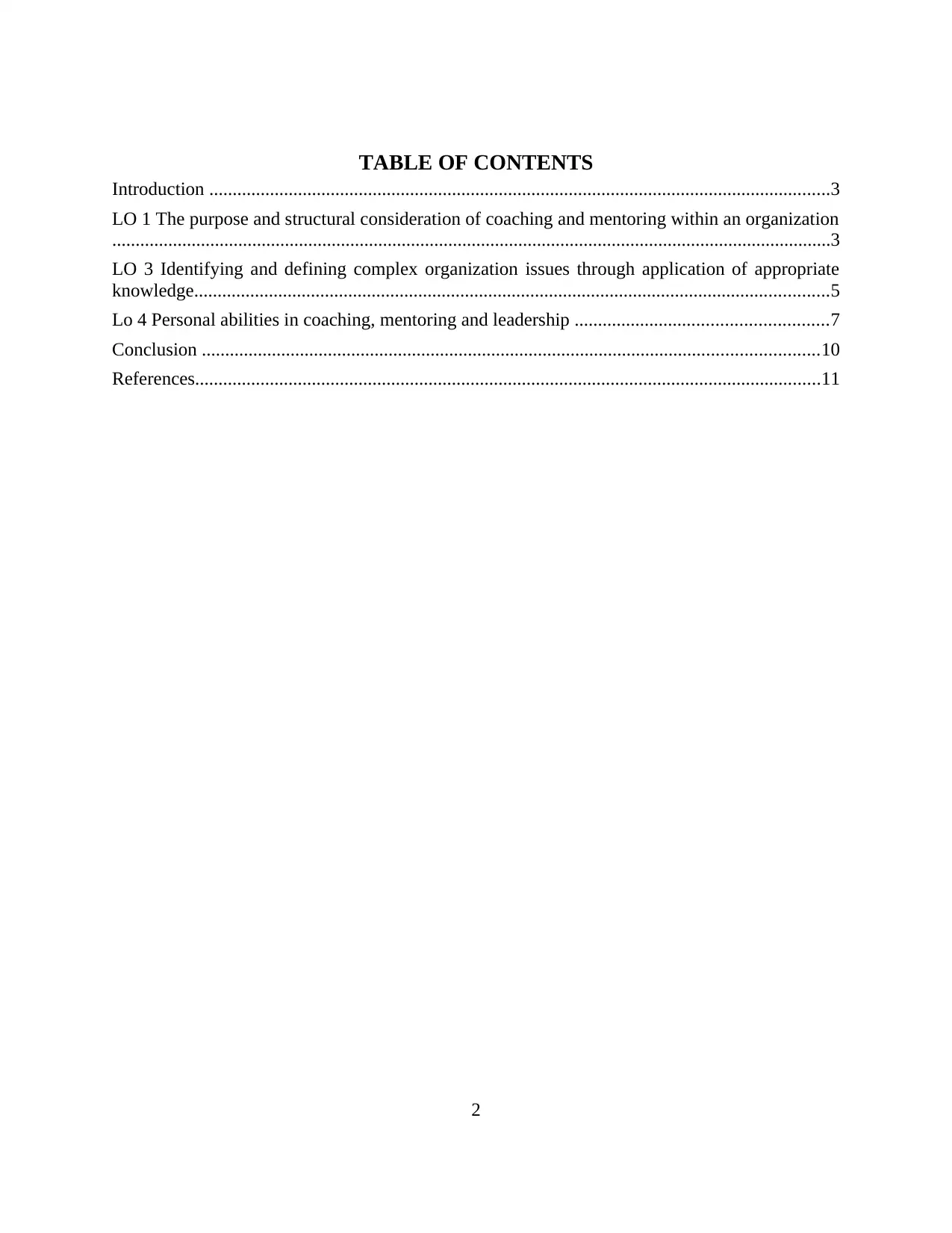
TABLE OF CONTENTS
Introduction .....................................................................................................................................3
LO 1 The purpose and structural consideration of coaching and mentoring within an organization
..........................................................................................................................................................3
LO 3 Identifying and defining complex organization issues through application of appropriate
knowledge........................................................................................................................................5
Lo 4 Personal abilities in coaching, mentoring and leadership ......................................................7
Conclusion ....................................................................................................................................10
References......................................................................................................................................11
2
Introduction .....................................................................................................................................3
LO 1 The purpose and structural consideration of coaching and mentoring within an organization
..........................................................................................................................................................3
LO 3 Identifying and defining complex organization issues through application of appropriate
knowledge........................................................................................................................................5
Lo 4 Personal abilities in coaching, mentoring and leadership ......................................................7
Conclusion ....................................................................................................................................10
References......................................................................................................................................11
2

INTRODUCTION
In the present scenario, employees have become one of the most important and crucial
aspects of businesses (Garvey, Stokes and Megginson, 2014). It can be stated that two companies
may have same machines, technology, infrastructure and financial resources but what make one
differ from another is their human resources (Connor and Pokora, 2012). Nowadays,
organization has started to lay more and more emphasis on areas such as coaching and mentoring
in order to enhance knowledge, skill set of workers and make them more productive. The present
research report explains the purpose and structure of coaching and mentoring which has been
adopted by the retailer. Along with this, it also highlights different type of complex issues which
has been faced by organizations in terms of applying appropriate knowledge.
LO 1 THE PURPOSE AND STRUCTURAL CONSIDERATION OF
COACHING AND MENTORING WITHIN AN ORGANIZATION
In general terms, coaching can be defined as the process in which one individual support
others in learning new things, enhancing existing skills and become successful. However, from
an organization point of view, coaching is simply defined as the process which lay emphasis on
enhancing productivity of workers by assigning them with a particular coach (The difference
between mentoring and coaching, 2015). It can be considered as a method of teaching or training
which is usually carried out with one to one support (Parsloe, 2009). It can be stated that the key
purpose behind coaching is to developed abilities and skills set of people in the organization.
Furthermore, different types of coach are being assigned to employee in order to train them and
more them more effective.
At present the competition among businesses every industry has become so intense that it
is not easy for companies to attract customers and retain their old ones. In addition to this,
nowadays customers are available with a variety of options to choose from and this has also
resulted in creating different kind of obstacles in long term growth and success of organizations.
Therefore, various companies have started to lay emphasis on training their staff members with
the help of ways such as coaching. The rationale behind this is to teach or train workers in such a
way that they can understand need, demand of customers and provide satisfactory products and
services on the basis of same (Clutterbuck, 2008). Coaching helps employees to deliver effective,
3
In the present scenario, employees have become one of the most important and crucial
aspects of businesses (Garvey, Stokes and Megginson, 2014). It can be stated that two companies
may have same machines, technology, infrastructure and financial resources but what make one
differ from another is their human resources (Connor and Pokora, 2012). Nowadays,
organization has started to lay more and more emphasis on areas such as coaching and mentoring
in order to enhance knowledge, skill set of workers and make them more productive. The present
research report explains the purpose and structure of coaching and mentoring which has been
adopted by the retailer. Along with this, it also highlights different type of complex issues which
has been faced by organizations in terms of applying appropriate knowledge.
LO 1 THE PURPOSE AND STRUCTURAL CONSIDERATION OF
COACHING AND MENTORING WITHIN AN ORGANIZATION
In general terms, coaching can be defined as the process in which one individual support
others in learning new things, enhancing existing skills and become successful. However, from
an organization point of view, coaching is simply defined as the process which lay emphasis on
enhancing productivity of workers by assigning them with a particular coach (The difference
between mentoring and coaching, 2015). It can be considered as a method of teaching or training
which is usually carried out with one to one support (Parsloe, 2009). It can be stated that the key
purpose behind coaching is to developed abilities and skills set of people in the organization.
Furthermore, different types of coach are being assigned to employee in order to train them and
more them more effective.
At present the competition among businesses every industry has become so intense that it
is not easy for companies to attract customers and retain their old ones. In addition to this,
nowadays customers are available with a variety of options to choose from and this has also
resulted in creating different kind of obstacles in long term growth and success of organizations.
Therefore, various companies have started to lay emphasis on training their staff members with
the help of ways such as coaching. The rationale behind this is to teach or train workers in such a
way that they can understand need, demand of customers and provide satisfactory products and
services on the basis of same (Clutterbuck, 2008). Coaching helps employees to deliver effective,
3
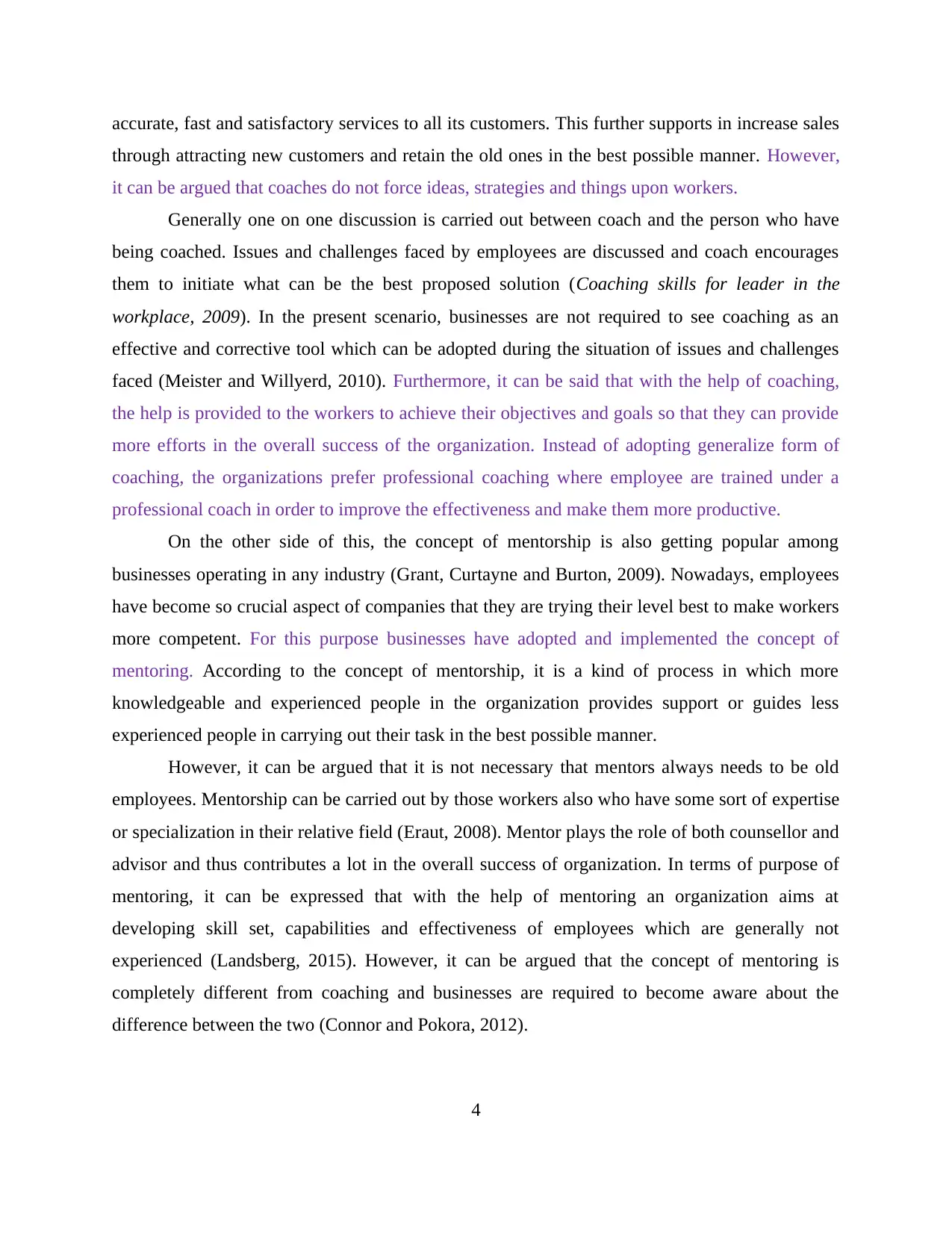
accurate, fast and satisfactory services to all its customers. This further supports in increase sales
through attracting new customers and retain the old ones in the best possible manner. However,
it can be argued that coaches do not force ideas, strategies and things upon workers.
Generally one on one discussion is carried out between coach and the person who have
being coached. Issues and challenges faced by employees are discussed and coach encourages
them to initiate what can be the best proposed solution (Coaching skills for leader in the
workplace, 2009). In the present scenario, businesses are not required to see coaching as an
effective and corrective tool which can be adopted during the situation of issues and challenges
faced (Meister and Willyerd, 2010). Furthermore, it can be said that with the help of coaching,
the help is provided to the workers to achieve their objectives and goals so that they can provide
more efforts in the overall success of the organization. Instead of adopting generalize form of
coaching, the organizations prefer professional coaching where employee are trained under a
professional coach in order to improve the effectiveness and make them more productive.
On the other side of this, the concept of mentorship is also getting popular among
businesses operating in any industry (Grant, Curtayne and Burton, 2009). Nowadays, employees
have become so crucial aspect of companies that they are trying their level best to make workers
more competent. For this purpose businesses have adopted and implemented the concept of
mentoring. According to the concept of mentorship, it is a kind of process in which more
knowledgeable and experienced people in the organization provides support or guides less
experienced people in carrying out their task in the best possible manner.
However, it can be argued that it is not necessary that mentors always needs to be old
employees. Mentorship can be carried out by those workers also who have some sort of expertise
or specialization in their relative field (Eraut, 2008). Mentor plays the role of both counsellor and
advisor and thus contributes a lot in the overall success of organization. In terms of purpose of
mentoring, it can be expressed that with the help of mentoring an organization aims at
developing skill set, capabilities and effectiveness of employees which are generally not
experienced (Landsberg, 2015). However, it can be argued that the concept of mentoring is
completely different from coaching and businesses are required to become aware about the
difference between the two (Connor and Pokora, 2012).
4
through attracting new customers and retain the old ones in the best possible manner. However,
it can be argued that coaches do not force ideas, strategies and things upon workers.
Generally one on one discussion is carried out between coach and the person who have
being coached. Issues and challenges faced by employees are discussed and coach encourages
them to initiate what can be the best proposed solution (Coaching skills for leader in the
workplace, 2009). In the present scenario, businesses are not required to see coaching as an
effective and corrective tool which can be adopted during the situation of issues and challenges
faced (Meister and Willyerd, 2010). Furthermore, it can be said that with the help of coaching,
the help is provided to the workers to achieve their objectives and goals so that they can provide
more efforts in the overall success of the organization. Instead of adopting generalize form of
coaching, the organizations prefer professional coaching where employee are trained under a
professional coach in order to improve the effectiveness and make them more productive.
On the other side of this, the concept of mentorship is also getting popular among
businesses operating in any industry (Grant, Curtayne and Burton, 2009). Nowadays, employees
have become so crucial aspect of companies that they are trying their level best to make workers
more competent. For this purpose businesses have adopted and implemented the concept of
mentoring. According to the concept of mentorship, it is a kind of process in which more
knowledgeable and experienced people in the organization provides support or guides less
experienced people in carrying out their task in the best possible manner.
However, it can be argued that it is not necessary that mentors always needs to be old
employees. Mentorship can be carried out by those workers also who have some sort of expertise
or specialization in their relative field (Eraut, 2008). Mentor plays the role of both counsellor and
advisor and thus contributes a lot in the overall success of organization. In terms of purpose of
mentoring, it can be expressed that with the help of mentoring an organization aims at
developing skill set, capabilities and effectiveness of employees which are generally not
experienced (Landsberg, 2015). However, it can be argued that the concept of mentoring is
completely different from coaching and businesses are required to become aware about the
difference between the two (Connor and Pokora, 2012).
4
Paraphrase This Document
Need a fresh take? Get an instant paraphrase of this document with our AI Paraphraser
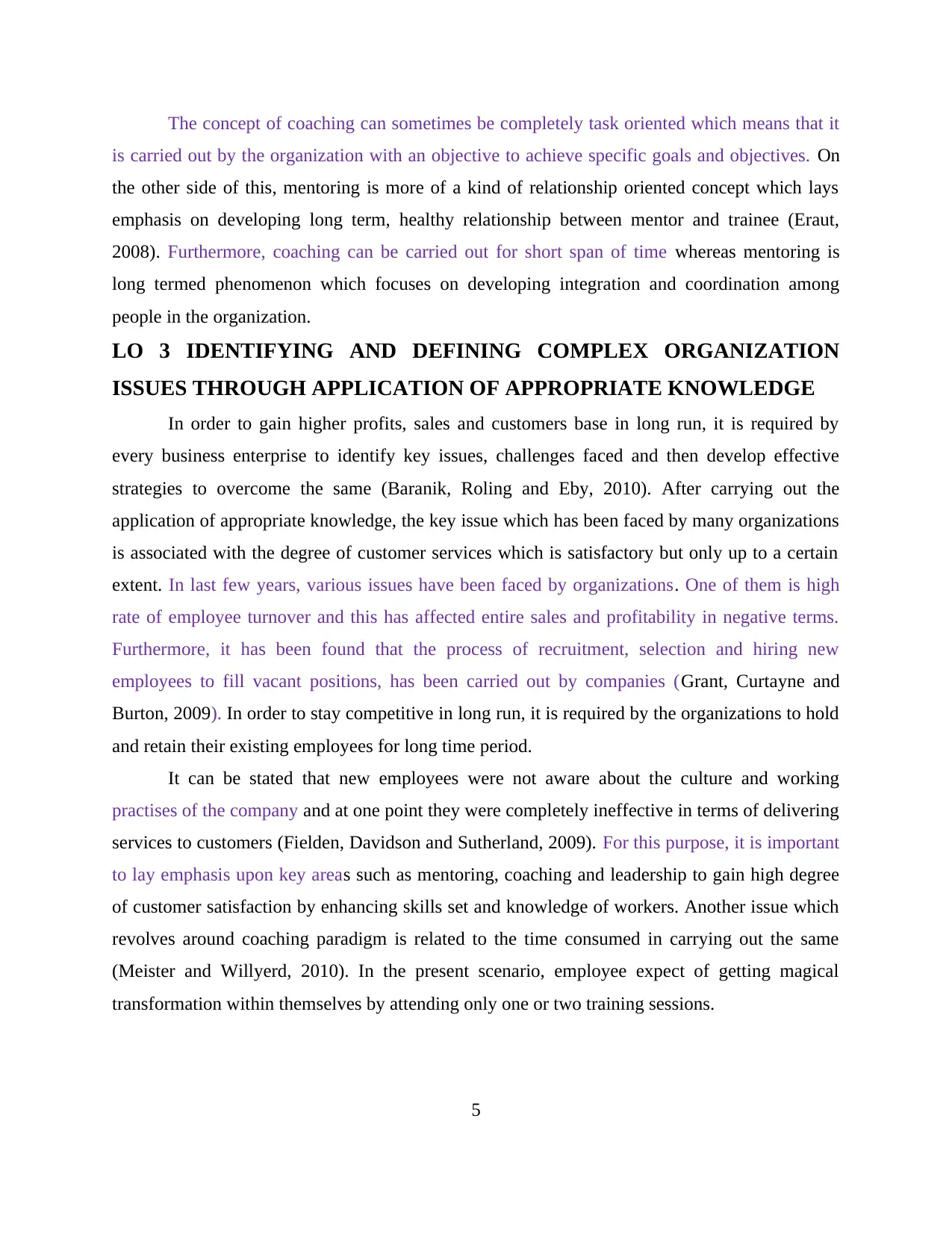
The concept of coaching can sometimes be completely task oriented which means that it
is carried out by the organization with an objective to achieve specific goals and objectives. On
the other side of this, mentoring is more of a kind of relationship oriented concept which lays
emphasis on developing long term, healthy relationship between mentor and trainee (Eraut,
2008). Furthermore, coaching can be carried out for short span of time whereas mentoring is
long termed phenomenon which focuses on developing integration and coordination among
people in the organization.
LO 3 IDENTIFYING AND DEFINING COMPLEX ORGANIZATION
ISSUES THROUGH APPLICATION OF APPROPRIATE KNOWLEDGE
In order to gain higher profits, sales and customers base in long run, it is required by
every business enterprise to identify key issues, challenges faced and then develop effective
strategies to overcome the same (Baranik, Roling and Eby, 2010). After carrying out the
application of appropriate knowledge, the key issue which has been faced by many organizations
is associated with the degree of customer services which is satisfactory but only up to a certain
extent. In last few years, various issues have been faced by organizations. One of them is high
rate of employee turnover and this has affected entire sales and profitability in negative terms.
Furthermore, it has been found that the process of recruitment, selection and hiring new
employees to fill vacant positions, has been carried out by companies (Grant, Curtayne and
Burton, 2009). In order to stay competitive in long run, it is required by the organizations to hold
and retain their existing employees for long time period.
It can be stated that new employees were not aware about the culture and working
practises of the company and at one point they were completely ineffective in terms of delivering
services to customers (Fielden, Davidson and Sutherland, 2009). For this purpose, it is important
to lay emphasis upon key areas such as mentoring, coaching and leadership to gain high degree
of customer satisfaction by enhancing skills set and knowledge of workers. Another issue which
revolves around coaching paradigm is related to the time consumed in carrying out the same
(Meister and Willyerd, 2010). In the present scenario, employee expect of getting magical
transformation within themselves by attending only one or two training sessions.
5
is carried out by the organization with an objective to achieve specific goals and objectives. On
the other side of this, mentoring is more of a kind of relationship oriented concept which lays
emphasis on developing long term, healthy relationship between mentor and trainee (Eraut,
2008). Furthermore, coaching can be carried out for short span of time whereas mentoring is
long termed phenomenon which focuses on developing integration and coordination among
people in the organization.
LO 3 IDENTIFYING AND DEFINING COMPLEX ORGANIZATION
ISSUES THROUGH APPLICATION OF APPROPRIATE KNOWLEDGE
In order to gain higher profits, sales and customers base in long run, it is required by
every business enterprise to identify key issues, challenges faced and then develop effective
strategies to overcome the same (Baranik, Roling and Eby, 2010). After carrying out the
application of appropriate knowledge, the key issue which has been faced by many organizations
is associated with the degree of customer services which is satisfactory but only up to a certain
extent. In last few years, various issues have been faced by organizations. One of them is high
rate of employee turnover and this has affected entire sales and profitability in negative terms.
Furthermore, it has been found that the process of recruitment, selection and hiring new
employees to fill vacant positions, has been carried out by companies (Grant, Curtayne and
Burton, 2009). In order to stay competitive in long run, it is required by the organizations to hold
and retain their existing employees for long time period.
It can be stated that new employees were not aware about the culture and working
practises of the company and at one point they were completely ineffective in terms of delivering
services to customers (Fielden, Davidson and Sutherland, 2009). For this purpose, it is important
to lay emphasis upon key areas such as mentoring, coaching and leadership to gain high degree
of customer satisfaction by enhancing skills set and knowledge of workers. Another issue which
revolves around coaching paradigm is related to the time consumed in carrying out the same
(Meister and Willyerd, 2010). In the present scenario, employee expect of getting magical
transformation within themselves by attending only one or two training sessions.
5
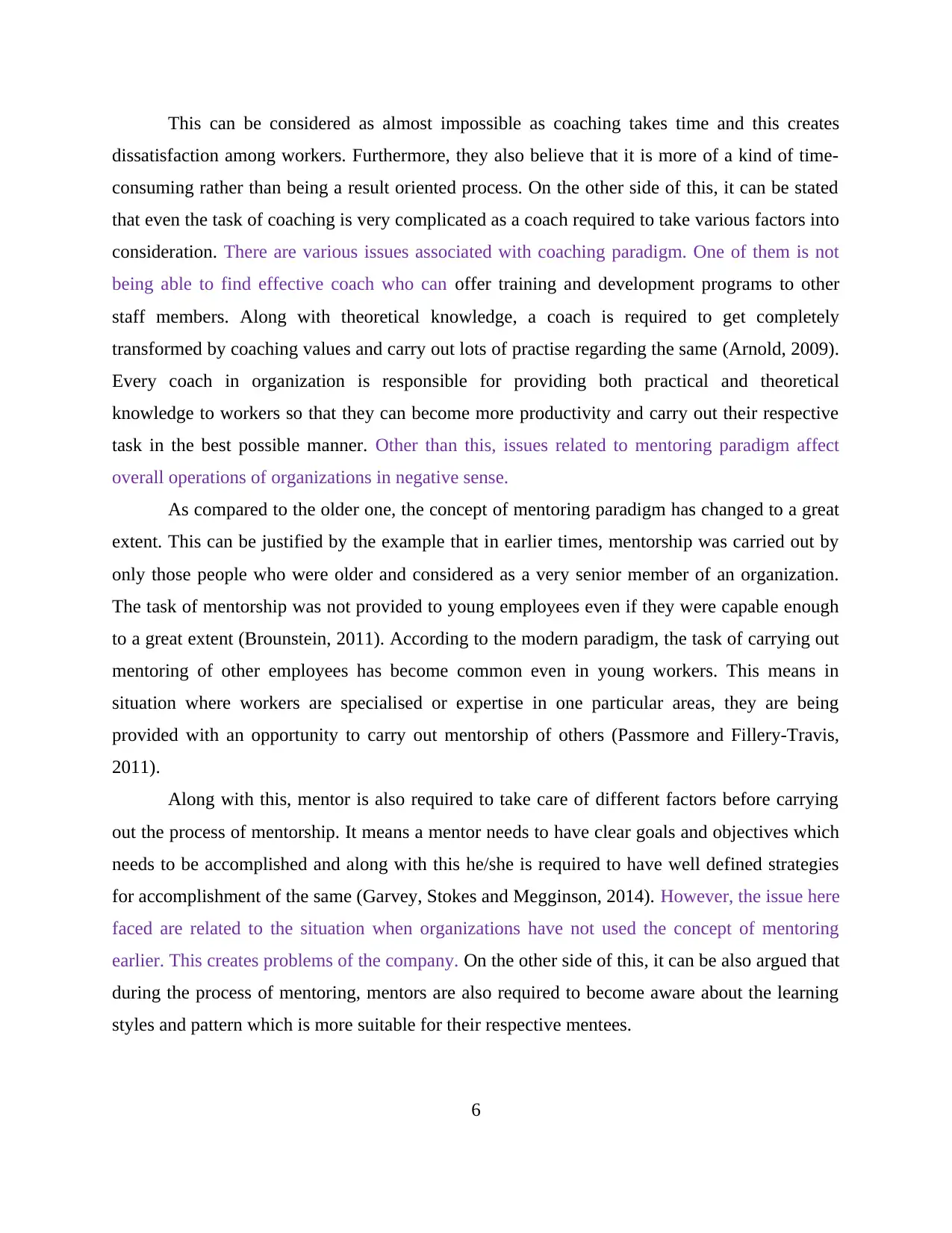
This can be considered as almost impossible as coaching takes time and this creates
dissatisfaction among workers. Furthermore, they also believe that it is more of a kind of time-
consuming rather than being a result oriented process. On the other side of this, it can be stated
that even the task of coaching is very complicated as a coach required to take various factors into
consideration. There are various issues associated with coaching paradigm. One of them is not
being able to find effective coach who can offer training and development programs to other
staff members. Along with theoretical knowledge, a coach is required to get completely
transformed by coaching values and carry out lots of practise regarding the same (Arnold, 2009).
Every coach in organization is responsible for providing both practical and theoretical
knowledge to workers so that they can become more productivity and carry out their respective
task in the best possible manner. Other than this, issues related to mentoring paradigm affect
overall operations of organizations in negative sense.
As compared to the older one, the concept of mentoring paradigm has changed to a great
extent. This can be justified by the example that in earlier times, mentorship was carried out by
only those people who were older and considered as a very senior member of an organization.
The task of mentorship was not provided to young employees even if they were capable enough
to a great extent (Brounstein, 2011). According to the modern paradigm, the task of carrying out
mentoring of other employees has become common even in young workers. This means in
situation where workers are specialised or expertise in one particular areas, they are being
provided with an opportunity to carry out mentorship of others (Passmore and Fillery-Travis,
2011).
Along with this, mentor is also required to take care of different factors before carrying
out the process of mentorship. It means a mentor needs to have clear goals and objectives which
needs to be accomplished and along with this he/she is required to have well defined strategies
for accomplishment of the same (Garvey, Stokes and Megginson, 2014). However, the issue here
faced are related to the situation when organizations have not used the concept of mentoring
earlier. This creates problems of the company. On the other side of this, it can be also argued that
during the process of mentoring, mentors are also required to become aware about the learning
styles and pattern which is more suitable for their respective mentees.
6
dissatisfaction among workers. Furthermore, they also believe that it is more of a kind of time-
consuming rather than being a result oriented process. On the other side of this, it can be stated
that even the task of coaching is very complicated as a coach required to take various factors into
consideration. There are various issues associated with coaching paradigm. One of them is not
being able to find effective coach who can offer training and development programs to other
staff members. Along with theoretical knowledge, a coach is required to get completely
transformed by coaching values and carry out lots of practise regarding the same (Arnold, 2009).
Every coach in organization is responsible for providing both practical and theoretical
knowledge to workers so that they can become more productivity and carry out their respective
task in the best possible manner. Other than this, issues related to mentoring paradigm affect
overall operations of organizations in negative sense.
As compared to the older one, the concept of mentoring paradigm has changed to a great
extent. This can be justified by the example that in earlier times, mentorship was carried out by
only those people who were older and considered as a very senior member of an organization.
The task of mentorship was not provided to young employees even if they were capable enough
to a great extent (Brounstein, 2011). According to the modern paradigm, the task of carrying out
mentoring of other employees has become common even in young workers. This means in
situation where workers are specialised or expertise in one particular areas, they are being
provided with an opportunity to carry out mentorship of others (Passmore and Fillery-Travis,
2011).
Along with this, mentor is also required to take care of different factors before carrying
out the process of mentorship. It means a mentor needs to have clear goals and objectives which
needs to be accomplished and along with this he/she is required to have well defined strategies
for accomplishment of the same (Garvey, Stokes and Megginson, 2014). However, the issue here
faced are related to the situation when organizations have not used the concept of mentoring
earlier. This creates problems of the company. On the other side of this, it can be also argued that
during the process of mentoring, mentors are also required to become aware about the learning
styles and pattern which is more suitable for their respective mentees.
6

The complex organization issue is also related to workers sometimes. This is when a
business is not able to manage and maintain performance of all its staff members. This also
results in lowering down sales, profits, market share and degree of customer satisfaction
(Baranik, Roling and Eby, 2010). As it has been already discussed that the degree of competition
in every industry has become so intense that it is not easy to gain competitive advantage over
other market players. Therefore, the there is a need to carry out effective practises of mentoring
and coaching to improve effectiveness, performance and overall efficiency of employees
(Fielden, Davidson and Sutherland, 2009).
LO 4 PERSONAL ABILITIES IN COACHING, MENTORING AND
LEADERSHIP
At present my core responsibilities includes increasing sales and profitability of the
organization where I work. My job has become very challenging as it is not an easy task to
attract customers, increase sales in situations of such intense competition prevailing in the
market. It can be also stated that I have performed the role of mentor, coach and leader in the
organization and provided best possible results regarding the same. However, at the time of
carrying out the above mentioned three roles I have ensured that need, demand and views of
workers or other staff members are always taken into consideration.
I have also provided coaching in situations where new employee have been hired and
they were not able to meet their expectations. Here, I have provided them teaching programs and
training sessions so that they can become effective and understand the ways in which satisfactory
services can be provided to client. On the other side of this, it can be stated that the reason why
my coaching is considered as effective is that before proceeding further, I have looked forward
for listening to issues and challenges which those new employees were facing. Furthermore, on
the basis of those identified problem, I have developed and implemented plans/ strategies for
carrying out coaching.
Other than this, I have given full and complete attention to each and every conversation
and this has also supported me in carrying out my responsibilities as a coach in more effective
manner. Instead of focusing only upon teaching and training, I have also given preference to
areas such as inspiring and motivating others. For this purpose, I have applied different tools and
7
business is not able to manage and maintain performance of all its staff members. This also
results in lowering down sales, profits, market share and degree of customer satisfaction
(Baranik, Roling and Eby, 2010). As it has been already discussed that the degree of competition
in every industry has become so intense that it is not easy to gain competitive advantage over
other market players. Therefore, the there is a need to carry out effective practises of mentoring
and coaching to improve effectiveness, performance and overall efficiency of employees
(Fielden, Davidson and Sutherland, 2009).
LO 4 PERSONAL ABILITIES IN COACHING, MENTORING AND
LEADERSHIP
At present my core responsibilities includes increasing sales and profitability of the
organization where I work. My job has become very challenging as it is not an easy task to
attract customers, increase sales in situations of such intense competition prevailing in the
market. It can be also stated that I have performed the role of mentor, coach and leader in the
organization and provided best possible results regarding the same. However, at the time of
carrying out the above mentioned three roles I have ensured that need, demand and views of
workers or other staff members are always taken into consideration.
I have also provided coaching in situations where new employee have been hired and
they were not able to meet their expectations. Here, I have provided them teaching programs and
training sessions so that they can become effective and understand the ways in which satisfactory
services can be provided to client. On the other side of this, it can be stated that the reason why
my coaching is considered as effective is that before proceeding further, I have looked forward
for listening to issues and challenges which those new employees were facing. Furthermore, on
the basis of those identified problem, I have developed and implemented plans/ strategies for
carrying out coaching.
Other than this, I have given full and complete attention to each and every conversation
and this has also supported me in carrying out my responsibilities as a coach in more effective
manner. Instead of focusing only upon teaching and training, I have also given preference to
areas such as inspiring and motivating others. For this purpose, I have applied different tools and
7
Secure Best Marks with AI Grader
Need help grading? Try our AI Grader for instant feedback on your assignments.

techniques of motivation. For example at the time of carrying out training sessions, I have
motivated workers by clearly communicating them that serving workers in satisfactory manner
will not only benefit organization but will also support them in getting better growth and
development opportunities in the future.
Along with this, patient and understanding are the two key qualities of me which has
supported in me in becoming an effective coach. Furthermore, at the time of coaching I was well
aware about the strengths and weakness of every person to whom I was providing training
sessions. I have supported them in developing strategies through which they can improve their
strengths and overcome their weaknesses.
At the time of carrying out the process of mentoring I have provided more preference to
relationship making instead of all other areas. I am aware of the fact that mentoring is a long
term process and thus relationship between people involved in mentorship is must. I have
personally achieved success in area of mentorship by being credible for almost everything. The
rationale behind this is that my credibility has supported and encouraged other people working in
organization to seek for my support in guidance in area related to the field of marketing.
During the period of mentorship, I have helped other members or new people to reach at
the point of decision making. However, it can be argued that one of the best strategy I have
applied during the tenure of mentorship was of encouraging employees to develop ideas and
solution with their own critical thinking. This has boosted up the morale and motivation of
workers and also resulted in increasing their confidence level. On the other side of this, I was
genuinely interested in all my mentees at the time of carrying out their mentorship. I was well
aware of the fact that in order to become successful mentor, I was required to develop both
personal and professional relationship with all my respective mentees.
For this purpose I have always encouraged them to share their views, aim and dreams
with me without any kind of hesitations. Furthermore, I have supported them in accomplishment
of their views by helping them in developing strategies related to the same. Another best practise
which I have adopted at the time of carrying out mentorship was of sharing my personal insights
and knowledge with them. During such sessions, I was looking forward for enhancing their
practical knowledge and which has further supported all my mentees in accomplishment of their
roles and responsibilities in the best possible manner. On contrary of this, it can be expressed that
8
motivated workers by clearly communicating them that serving workers in satisfactory manner
will not only benefit organization but will also support them in getting better growth and
development opportunities in the future.
Along with this, patient and understanding are the two key qualities of me which has
supported in me in becoming an effective coach. Furthermore, at the time of coaching I was well
aware about the strengths and weakness of every person to whom I was providing training
sessions. I have supported them in developing strategies through which they can improve their
strengths and overcome their weaknesses.
At the time of carrying out the process of mentoring I have provided more preference to
relationship making instead of all other areas. I am aware of the fact that mentoring is a long
term process and thus relationship between people involved in mentorship is must. I have
personally achieved success in area of mentorship by being credible for almost everything. The
rationale behind this is that my credibility has supported and encouraged other people working in
organization to seek for my support in guidance in area related to the field of marketing.
During the period of mentorship, I have helped other members or new people to reach at
the point of decision making. However, it can be argued that one of the best strategy I have
applied during the tenure of mentorship was of encouraging employees to develop ideas and
solution with their own critical thinking. This has boosted up the morale and motivation of
workers and also resulted in increasing their confidence level. On the other side of this, I was
genuinely interested in all my mentees at the time of carrying out their mentorship. I was well
aware of the fact that in order to become successful mentor, I was required to develop both
personal and professional relationship with all my respective mentees.
For this purpose I have always encouraged them to share their views, aim and dreams
with me without any kind of hesitations. Furthermore, I have supported them in accomplishment
of their views by helping them in developing strategies related to the same. Another best practise
which I have adopted at the time of carrying out mentorship was of sharing my personal insights
and knowledge with them. During such sessions, I was looking forward for enhancing their
practical knowledge and which has further supported all my mentees in accomplishment of their
roles and responsibilities in the best possible manner. On contrary of this, it can be expressed that
8
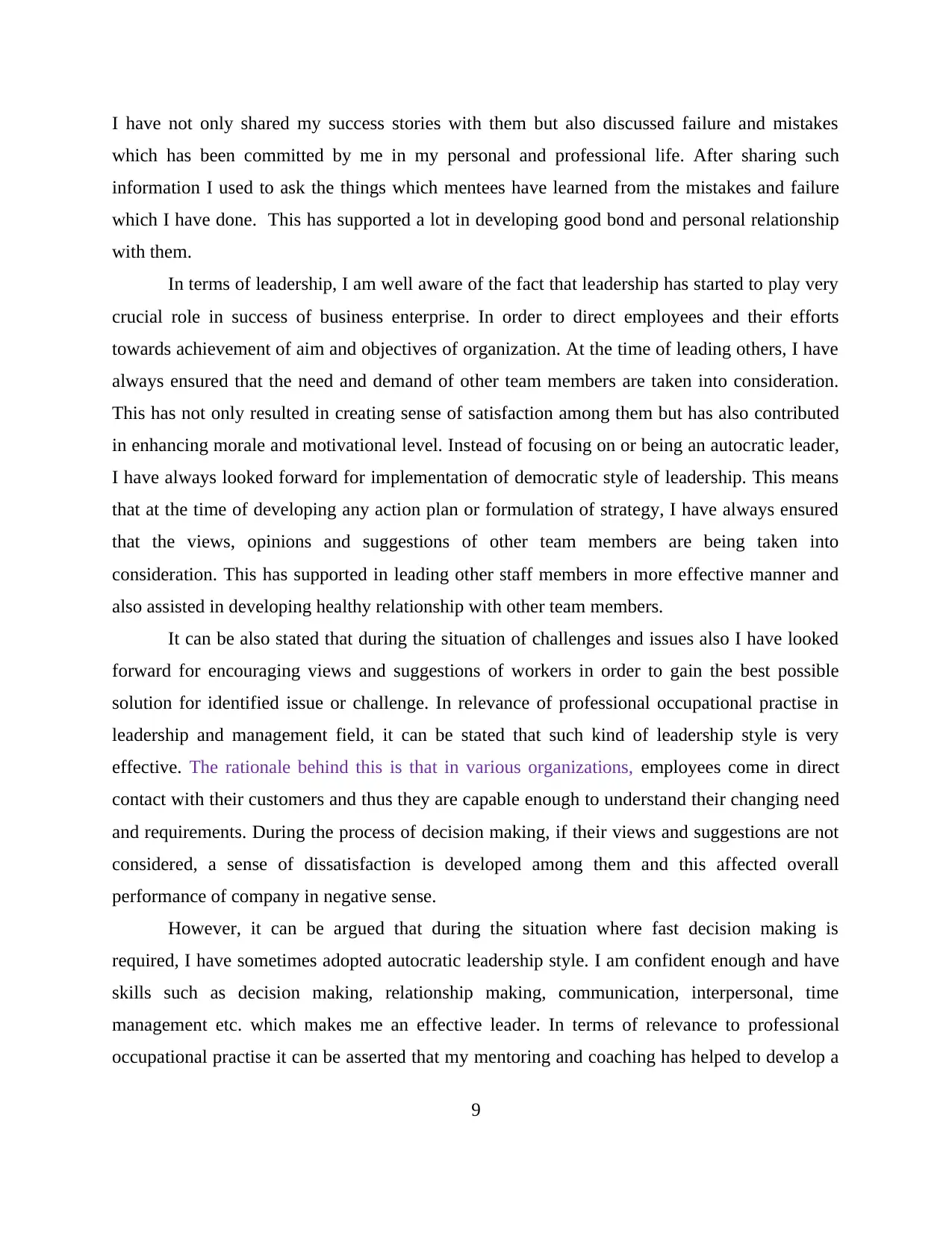
I have not only shared my success stories with them but also discussed failure and mistakes
which has been committed by me in my personal and professional life. After sharing such
information I used to ask the things which mentees have learned from the mistakes and failure
which I have done. This has supported a lot in developing good bond and personal relationship
with them.
In terms of leadership, I am well aware of the fact that leadership has started to play very
crucial role in success of business enterprise. In order to direct employees and their efforts
towards achievement of aim and objectives of organization. At the time of leading others, I have
always ensured that the need and demand of other team members are taken into consideration.
This has not only resulted in creating sense of satisfaction among them but has also contributed
in enhancing morale and motivational level. Instead of focusing on or being an autocratic leader,
I have always looked forward for implementation of democratic style of leadership. This means
that at the time of developing any action plan or formulation of strategy, I have always ensured
that the views, opinions and suggestions of other team members are being taken into
consideration. This has supported in leading other staff members in more effective manner and
also assisted in developing healthy relationship with other team members.
It can be also stated that during the situation of challenges and issues also I have looked
forward for encouraging views and suggestions of workers in order to gain the best possible
solution for identified issue or challenge. In relevance of professional occupational practise in
leadership and management field, it can be stated that such kind of leadership style is very
effective. The rationale behind this is that in various organizations, employees come in direct
contact with their customers and thus they are capable enough to understand their changing need
and requirements. During the process of decision making, if their views and suggestions are not
considered, a sense of dissatisfaction is developed among them and this affected overall
performance of company in negative sense.
However, it can be argued that during the situation where fast decision making is
required, I have sometimes adopted autocratic leadership style. I am confident enough and have
skills such as decision making, relationship making, communication, interpersonal, time
management etc. which makes me an effective leader. In terms of relevance to professional
occupational practise it can be asserted that my mentoring and coaching has helped to develop a
9
which has been committed by me in my personal and professional life. After sharing such
information I used to ask the things which mentees have learned from the mistakes and failure
which I have done. This has supported a lot in developing good bond and personal relationship
with them.
In terms of leadership, I am well aware of the fact that leadership has started to play very
crucial role in success of business enterprise. In order to direct employees and their efforts
towards achievement of aim and objectives of organization. At the time of leading others, I have
always ensured that the need and demand of other team members are taken into consideration.
This has not only resulted in creating sense of satisfaction among them but has also contributed
in enhancing morale and motivational level. Instead of focusing on or being an autocratic leader,
I have always looked forward for implementation of democratic style of leadership. This means
that at the time of developing any action plan or formulation of strategy, I have always ensured
that the views, opinions and suggestions of other team members are being taken into
consideration. This has supported in leading other staff members in more effective manner and
also assisted in developing healthy relationship with other team members.
It can be also stated that during the situation of challenges and issues also I have looked
forward for encouraging views and suggestions of workers in order to gain the best possible
solution for identified issue or challenge. In relevance of professional occupational practise in
leadership and management field, it can be stated that such kind of leadership style is very
effective. The rationale behind this is that in various organizations, employees come in direct
contact with their customers and thus they are capable enough to understand their changing need
and requirements. During the process of decision making, if their views and suggestions are not
considered, a sense of dissatisfaction is developed among them and this affected overall
performance of company in negative sense.
However, it can be argued that during the situation where fast decision making is
required, I have sometimes adopted autocratic leadership style. I am confident enough and have
skills such as decision making, relationship making, communication, interpersonal, time
management etc. which makes me an effective leader. In terms of relevance to professional
occupational practise it can be asserted that my mentoring and coaching has helped to develop a
9
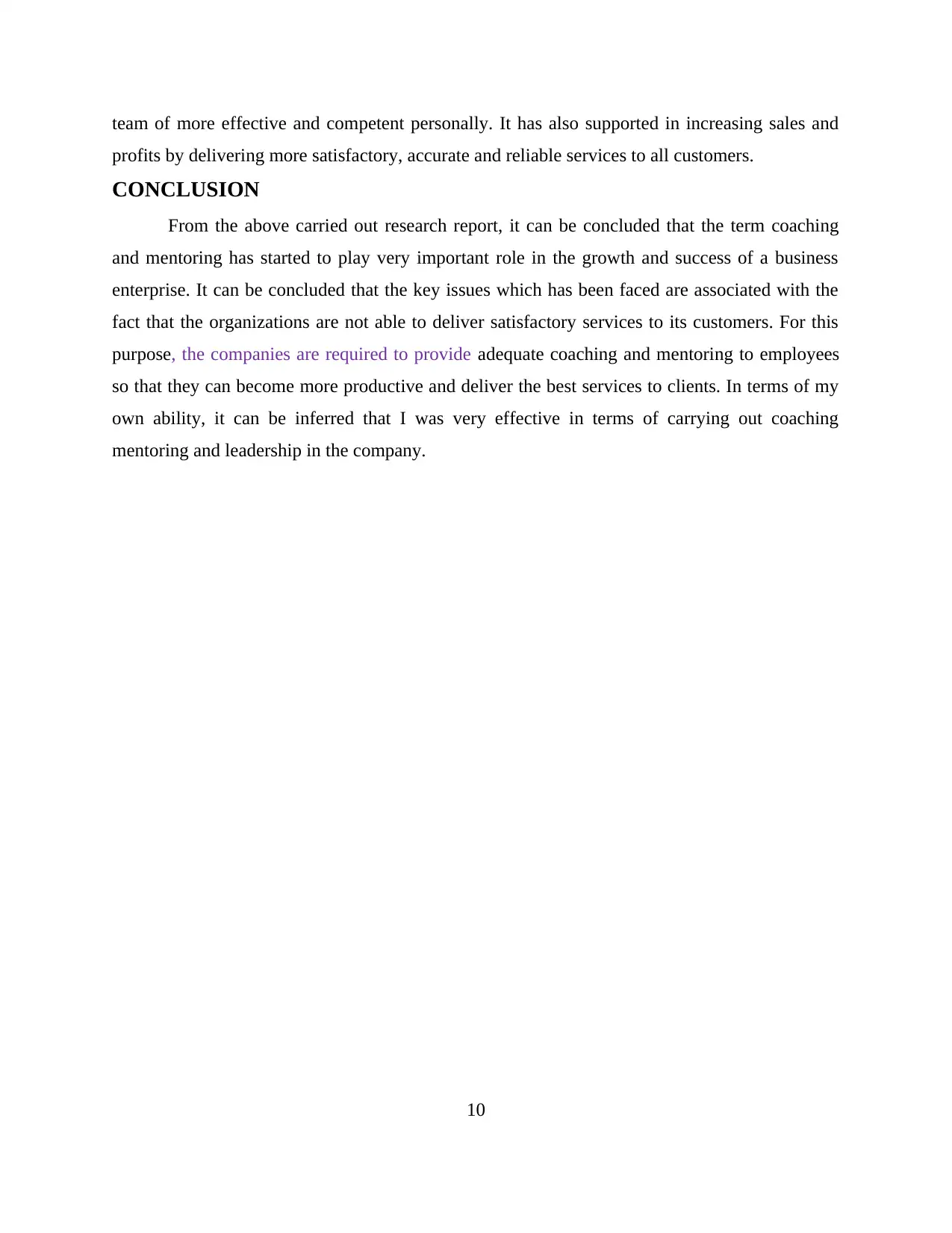
team of more effective and competent personally. It has also supported in increasing sales and
profits by delivering more satisfactory, accurate and reliable services to all customers.
CONCLUSION
From the above carried out research report, it can be concluded that the term coaching
and mentoring has started to play very important role in the growth and success of a business
enterprise. It can be concluded that the key issues which has been faced are associated with the
fact that the organizations are not able to deliver satisfactory services to its customers. For this
purpose, the companies are required to provide adequate coaching and mentoring to employees
so that they can become more productive and deliver the best services to clients. In terms of my
own ability, it can be inferred that I was very effective in terms of carrying out coaching
mentoring and leadership in the company.
10
profits by delivering more satisfactory, accurate and reliable services to all customers.
CONCLUSION
From the above carried out research report, it can be concluded that the term coaching
and mentoring has started to play very important role in the growth and success of a business
enterprise. It can be concluded that the key issues which has been faced are associated with the
fact that the organizations are not able to deliver satisfactory services to its customers. For this
purpose, the companies are required to provide adequate coaching and mentoring to employees
so that they can become more productive and deliver the best services to clients. In terms of my
own ability, it can be inferred that I was very effective in terms of carrying out coaching
mentoring and leadership in the company.
10
Paraphrase This Document
Need a fresh take? Get an instant paraphrase of this document with our AI Paraphraser
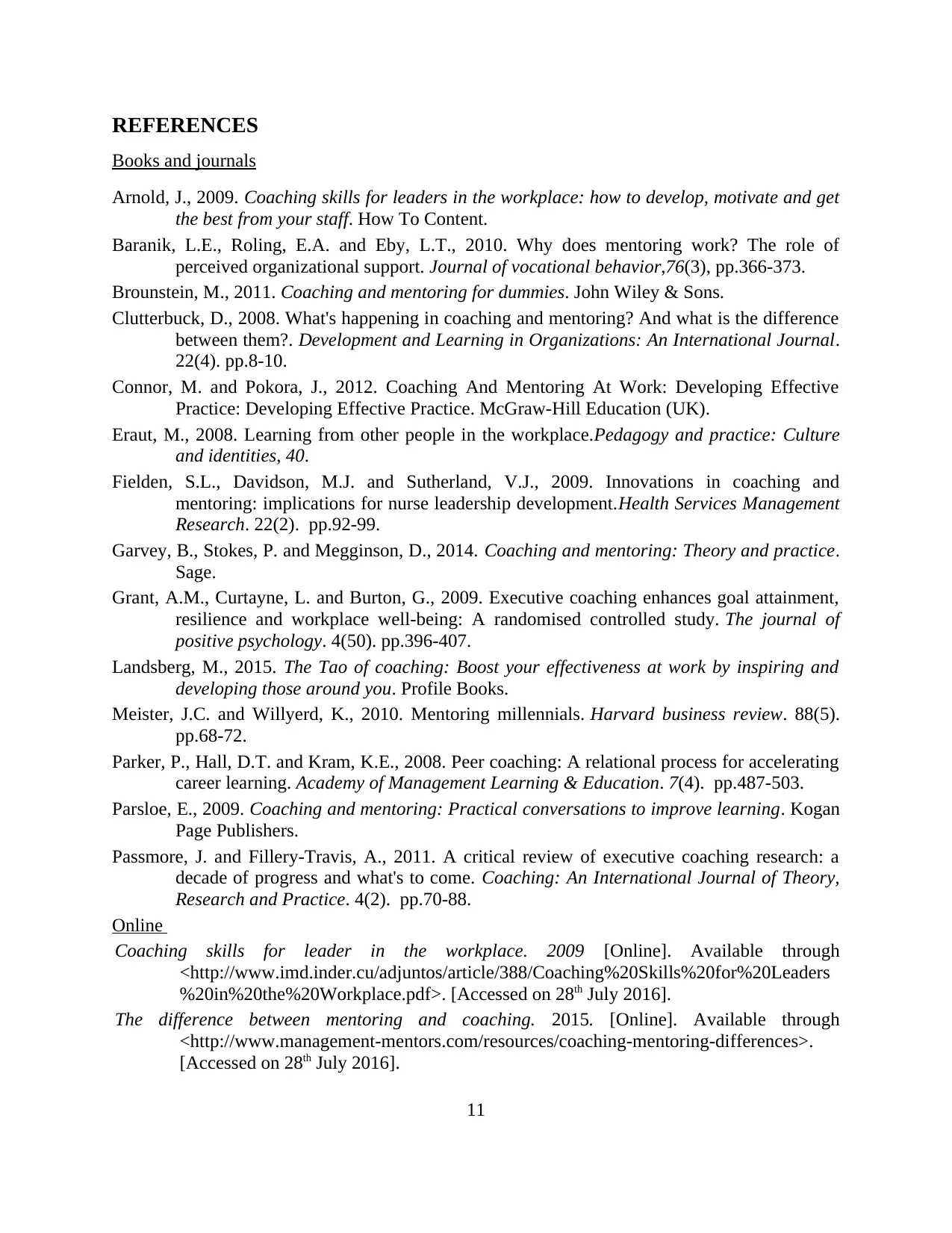
REFERENCES
Books and journals
Arnold, J., 2009. Coaching skills for leaders in the workplace: how to develop, motivate and get
the best from your staff. How To Content.
Baranik, L.E., Roling, E.A. and Eby, L.T., 2010. Why does mentoring work? The role of
perceived organizational support. Journal of vocational behavior,76(3), pp.366-373.
Brounstein, M., 2011. Coaching and mentoring for dummies. John Wiley & Sons.
Clutterbuck, D., 2008. What's happening in coaching and mentoring? And what is the difference
between them?. Development and Learning in Organizations: An International Journal.
22(4). pp.8-10.
Connor, M. and Pokora, J., 2012. Coaching And Mentoring At Work: Developing Effective
Practice: Developing Effective Practice. McGraw-Hill Education (UK).
Eraut, M., 2008. Learning from other people in the workplace.Pedagogy and practice: Culture
and identities, 40.
Fielden, S.L., Davidson, M.J. and Sutherland, V.J., 2009. Innovations in coaching and
mentoring: implications for nurse leadership development.Health Services Management
Research. 22(2). pp.92-99.
Garvey, B., Stokes, P. and Megginson, D., 2014. Coaching and mentoring: Theory and practice.
Sage.
Grant, A.M., Curtayne, L. and Burton, G., 2009. Executive coaching enhances goal attainment,
resilience and workplace well-being: A randomised controlled study. The journal of
positive psychology. 4(50). pp.396-407.
Landsberg, M., 2015. The Tao of coaching: Boost your effectiveness at work by inspiring and
developing those around you. Profile Books.
Meister, J.C. and Willyerd, K., 2010. Mentoring millennials. Harvard business review. 88(5).
pp.68-72.
Parker, P., Hall, D.T. and Kram, K.E., 2008. Peer coaching: A relational process for accelerating
career learning. Academy of Management Learning & Education. 7(4). pp.487-503.
Parsloe, E., 2009. Coaching and mentoring: Practical conversations to improve learning. Kogan
Page Publishers.
Passmore, J. and Fillery-Travis, A., 2011. A critical review of executive coaching research: a
decade of progress and what's to come. Coaching: An International Journal of Theory,
Research and Practice. 4(2). pp.70-88.
Online
Coaching skills for leader in the workplace. 2009 [Online]. Available through
<http://www.imd.inder.cu/adjuntos/article/388/Coaching%20Skills%20for%20Leaders
%20in%20the%20Workplace.pdf>. [Accessed on 28th July 2016].
The difference between mentoring and coaching. 2015. [Online]. Available through
<http://www.management-mentors.com/resources/coaching-mentoring-differences>.
[Accessed on 28th July 2016].
11
Books and journals
Arnold, J., 2009. Coaching skills for leaders in the workplace: how to develop, motivate and get
the best from your staff. How To Content.
Baranik, L.E., Roling, E.A. and Eby, L.T., 2010. Why does mentoring work? The role of
perceived organizational support. Journal of vocational behavior,76(3), pp.366-373.
Brounstein, M., 2011. Coaching and mentoring for dummies. John Wiley & Sons.
Clutterbuck, D., 2008. What's happening in coaching and mentoring? And what is the difference
between them?. Development and Learning in Organizations: An International Journal.
22(4). pp.8-10.
Connor, M. and Pokora, J., 2012. Coaching And Mentoring At Work: Developing Effective
Practice: Developing Effective Practice. McGraw-Hill Education (UK).
Eraut, M., 2008. Learning from other people in the workplace.Pedagogy and practice: Culture
and identities, 40.
Fielden, S.L., Davidson, M.J. and Sutherland, V.J., 2009. Innovations in coaching and
mentoring: implications for nurse leadership development.Health Services Management
Research. 22(2). pp.92-99.
Garvey, B., Stokes, P. and Megginson, D., 2014. Coaching and mentoring: Theory and practice.
Sage.
Grant, A.M., Curtayne, L. and Burton, G., 2009. Executive coaching enhances goal attainment,
resilience and workplace well-being: A randomised controlled study. The journal of
positive psychology. 4(50). pp.396-407.
Landsberg, M., 2015. The Tao of coaching: Boost your effectiveness at work by inspiring and
developing those around you. Profile Books.
Meister, J.C. and Willyerd, K., 2010. Mentoring millennials. Harvard business review. 88(5).
pp.68-72.
Parker, P., Hall, D.T. and Kram, K.E., 2008. Peer coaching: A relational process for accelerating
career learning. Academy of Management Learning & Education. 7(4). pp.487-503.
Parsloe, E., 2009. Coaching and mentoring: Practical conversations to improve learning. Kogan
Page Publishers.
Passmore, J. and Fillery-Travis, A., 2011. A critical review of executive coaching research: a
decade of progress and what's to come. Coaching: An International Journal of Theory,
Research and Practice. 4(2). pp.70-88.
Online
Coaching skills for leader in the workplace. 2009 [Online]. Available through
<http://www.imd.inder.cu/adjuntos/article/388/Coaching%20Skills%20for%20Leaders
%20in%20the%20Workplace.pdf>. [Accessed on 28th July 2016].
The difference between mentoring and coaching. 2015. [Online]. Available through
<http://www.management-mentors.com/resources/coaching-mentoring-differences>.
[Accessed on 28th July 2016].
11
1 out of 11
![[object Object]](/_next/static/media/star-bottom.7253800d.svg)





